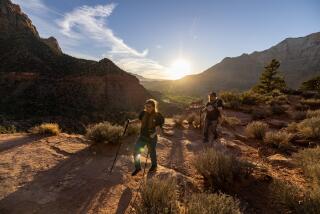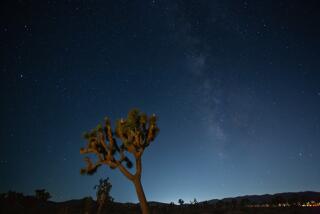John Dobson dies at 98; former monk developed easy-to-make telescope
- Share via
John Dobson, a former monk and self-taught stargazer who developed a powerful, inexpensive telescope that almost anyone could build and showed thousands how to do it during five decades as one of public astronomy’s most influential evangelists, has died. He was 98.
Dobson died Wednesday at Providence St. Joseph Medical Center in Burbank, said Bob Alborzian, coordinator of the Burbank chapter of Sidewalk Astronomers, an international organization that Dobson helped found in 1968. Dobson had been in poor health since a stroke a few years ago.
Called the “Johnny Appleseed of amateur astronomy,” the lanky, ponytailed Dobson started building telescopes in the 1950s when he was a monk at the Vedanta Monastery in San Francisco. His passion for the hobby led to his expulsion, freeing him to become a roving ambassador for the simple joys of studying the nighttime sky.
“He really wanted to just share viewing the sky with people,” said Anthony Cook, astronomical observer at Griffith Observatory. “He created a hobby and a type of telescope that ensured that people could build their own and look farther across the universe than was possible for most people before his time.”
Dobson used cheap or salvaged materials such as ship portholes and cardboard tubing to make his telescopes, the most radical feature of which is a simple, sturdy and highly effective wooden mount that allows users to easily point the scope at any spot in the sky.
His design was eventually embraced by commercial manufacturers, who advertise the telescopes as “Dobsonians.” They remain “one of the most popular telescopes on the market,” said Dennis di Cicco, senior editor of Sky & Telescope magazine.
Dobsonian telescopes have made important contributions to astronomy, including the discovery in 1995 of Comet Hale-Bopp, the farthest comet ever discovered by amateurs. One of its namesakes, Tom Bopp, was using a Dobsonian.
Alborzian, who had known Dobson since 1968, said he once urged Dobson to patent his design. Dobson refused. “He said, ‘These are gifts to humanity,’” Alborzian recalled. “His goal was to open astronomy to the common man.”
Dobson had his critics. He did not, for instance, subscribe to the big-bang theory but favored the idea of a “steady-state” universe with no beginning and no end. “I’m not interested in just the stars,” he told The Times in 2005. “I’m interested in the whole ball of wax.”
Although the steady-state theory has been widely discredited, Dobson was an unwavering supporter, which caused many in the astronomy establishment to dismiss him.
“He was unconventional,” Di Cicco said.
Dobson was born Sept. 14, 1915, in Beijing. His mother was a musician and his father taught zoology at Peking University. Nervous about political unrest in China, his family relocated to San Francisco in 1927. He earned a degree in chemistry from UC Berkeley in 1943 and went to work in the defense field.
An atheist since high school, he began to study Eastern religions after attending a lecture by Swami Ashokananda of the Vedanta Society. In 1944 he joined the Vedanta Monastery in San Francisco, where he was asked to reconcile the order’s teachings with science.
That assignment led him to build his first telescope, in 1956. He scavenged for materials, including a 12-inch porthole glass from a marine salvage yard that he sanded into a telescope mirror.
When he was done, he peered at the moon and was profoundly moved. “Everybody’s got to see this,” he said.
Transferred in 1958 to the order’s Sacramento monastery, he began building telescopes in earnest. Soon he took to stealth, smuggling parts into the monastery in fertilizer boxes after his superiors told him his activities were inappropriate for a monk.
He was often away from the monastery to help neighbors in the community construct their own scopes. That is what the other monks thought he was doing when they decided to expel him in 1967. According to his biography on the Sidewalk Astronomers website, he wasn’t neglecting his monastic duties that time but was weeding the lawn behind a monastery wall. Nevertheless, he was thrown out.
He hitchhiked to San Francisco, where he began teaching and setting up his telescopes on street corners. With the air of a carnival barker, he enticed passersby to look deeply into the heavens. “Come see the sun!” he shouted, sometimes while twirling a lariat.
Brusque and witty, he explained the cosmos in easily understood terms. “If the sun were the size of a basketball,” he often said, “Jupiter would be the size of a grape, and the Earth would be the size of a very small grape seed.”
In 1968, he formed the San Francisco Sidewalk Astronomers with Bruce Sams and Jeffrey Roloff, who had built telescopes under his tutelage. Soon, he was barnstorming the country, setting up his scopes in shopping center parking lots and national parks — anyplace, he said, “where dark skies and the public collide.”
With chapters across the country and abroad, Sidewalk Astronomers now has upward of 10,000 members, said Director Donna Smith.
In 1978 Dobson was invited to give a series of lectures at the Vedanta Society of Southern California and began to spend part of each year in Los Angeles. He lived at the Vedanta center in the Hollywood Hills, often hiking to Griffith Observatory, where he led public events such as a 12-hour telescope-building marathon in the mid-1980s.
His life was chronicled in films, including the 2005 documentary “A Sidewalk Astronomer,” directed by Jeffrey Fox Jacobs.
He is survived by a son, Loren, of Sacramento.
In his 90s, Dobson was still a gypsy proselytizer for astronomy, lecturing and giving workshops as far away as Russia and China.
Used to the most Spartan accommodations, he was known to sleep inside the scope’s cylindrical tubes when he was on the road.
“There’s one thing nice about sleeping in a telescope,” he told the Ventura County Star in 2007. “You can’t roll out of bed.”
More to Read
Start your day right
Sign up for Essential California for the L.A. Times biggest news, features and recommendations in your inbox six days a week.
You may occasionally receive promotional content from the Los Angeles Times.






